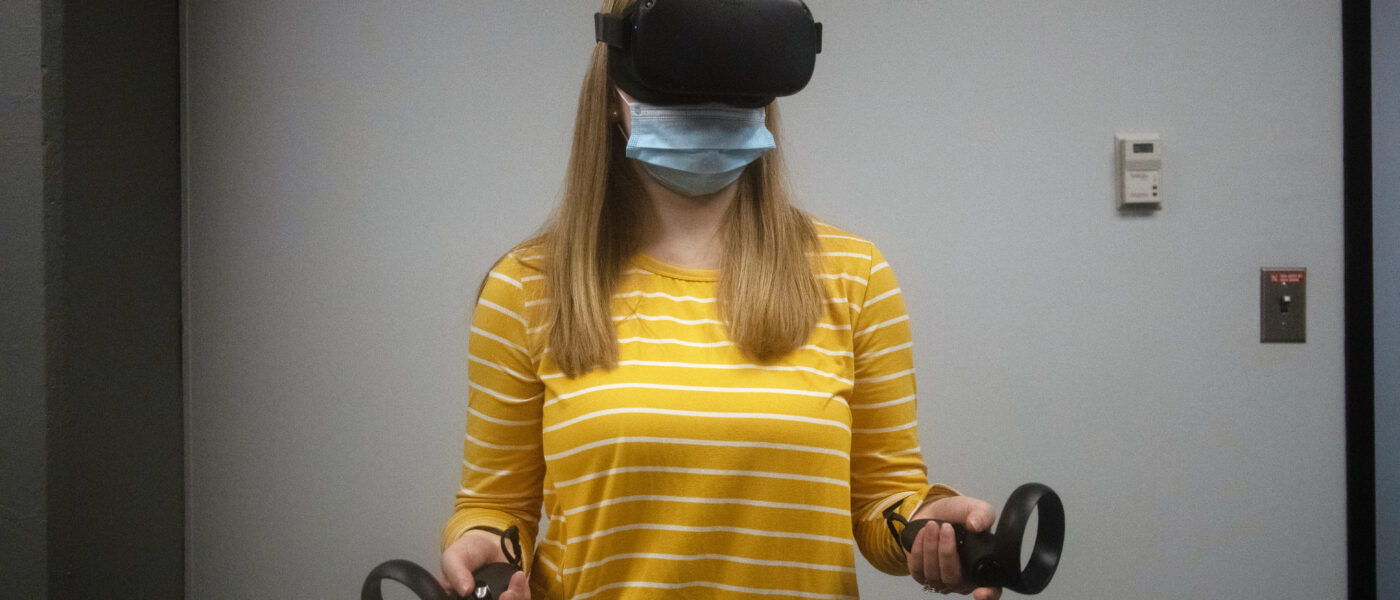Immersive VR in the Development of Speaking Skills
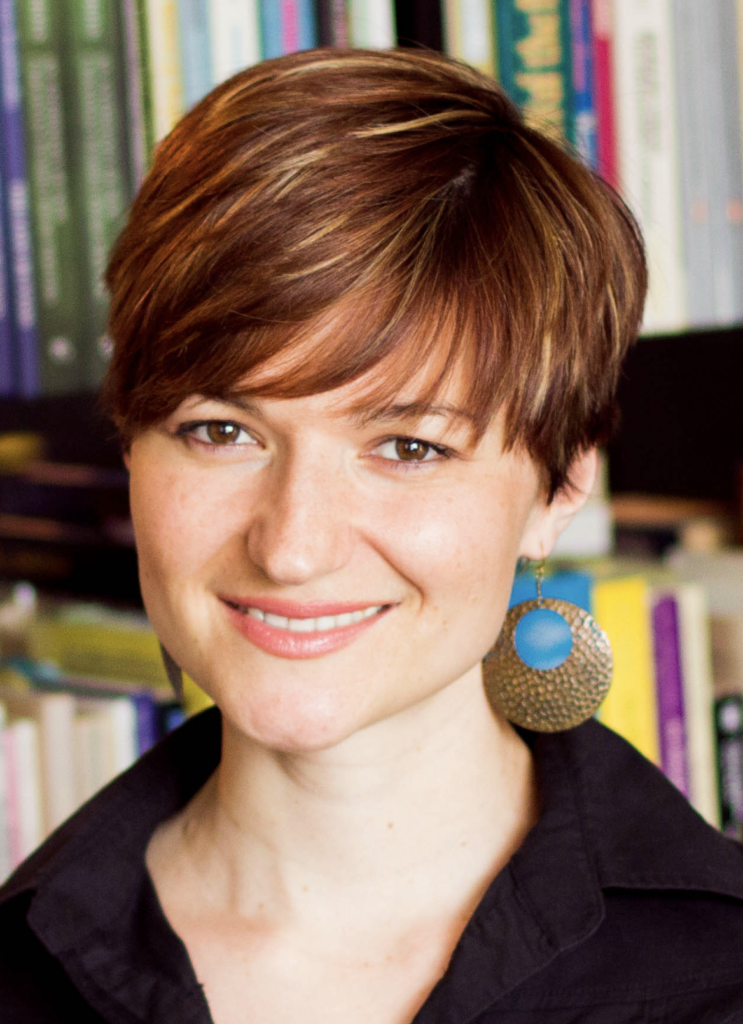 by Olha Tytarenko, Associate Professor of Practice of Russian, University of Nebraska-Lincoln.
by Olha Tytarenko, Associate Professor of Practice of Russian, University of Nebraska-Lincoln.
DOI: https://www.doi.org/10.69732/ATVO1964
Confessions of a Frustrated Educator
I wish I could say that my exploration of the uses of immersive technology started with my fascination with recent technological developments, my love for virtual reality, and the desire to make my classroom more engaging and exciting. Unfortunately, the main reason was the feeling of frustration I repeatedly experienced when reflecting on my students’ learning outcomes at the end of 300-level courses. Most of my students’ speaking proficiency was not where I wanted it to be.
In all my 300-level classes, my main goal for speaking proficiency is closely aligned with ACTFL’s expectation for Intermediate High. Performing some advanced-level tasks is also an essential part of the curriculum at this level. The main objective is to help students develop the skill to speak in a paragraph-length discourse on various topics covered in class and to practice rephrasing and circumlocution. Hence, I place a strong emphasis on vocabulary acquisition. I face several challenges when developing the curriculum at this level. My institution’s minimum enrollment at 300-level classes is 12, with the cap set at 22. Usually, our advanced courses have 14-16 students. Our three credit classes occur thrice weekly, and each session lasts fifty minutes. The in-class time with that number of students is often insufficient to push students’ speaking abilities from Intermediate Mid to Intermediate High. I made a few changes to improve students’ learning outcomes. These included:
- Flipping the classroom and structuring the work for students to be completed before and after the face-to-face session to focus in-class time on speaking practice.
- Creating a series of online speaking activities where every student can have a chance to practice a paragraph-long discourse regularly.
Still, the results did not meet my expectations, and the class size and limited time with students were difficult to overcome. Although several students showed definite progress in speaking outcomes, the online speaking practice did not prove efficient for many. Despite my strong prohibition against using any notes and script, despite the penalty for using any such prompts, students came up with creative ways to furnish their space around their cameras with all kinds of notes and prompts. Immersive technology became an unexpected solution to this problem as it “blindfolded” students in front of their cameras in addition to other advantages that the technology offers.
The Beginning of the Journey
I started using VR technology and experiential learning opportunities in the Fall of 2019. With my colleague in the Spanish section, Dr. Liz Enkin, I developed a project-based final assignment for the Russian through Art course that used VR and other media to enhance speaking proficiency and motivation in language learning. Subsequently, we published an article where we discussed the project, implementation, and students’ outcomes.
Notes on Course Objectives, The Final Project, and Conclusions
The course explored the Russian language and culture by studying a wide variety of masterpieces of Russian art, different genres and their characteristics, various artists and artistic movements, and the historical context in which artists lived and worked. One of the goals of this course was vocabulary acquisition for productive communication in the target language. The course included four major project-based assignments designed to encourage vocabulary acquisition, advance students’ communicative skills, and cultural competence, and promote authentic engagement with the target language. For two parts of the final project, students used Virtual Reality equipment at the language lab. I will focus on these parts in my description.
Part one of the final project tested both prepared and unprepared speeches. For the prepared speech, students had to explore the Light Italian Skylight Room in the Hermitage museum in St. Petersburg using two websites, 360 cities, and the Hermitage’s own website. On the 360 Cities website, students can watch this room in VR.

The Hermitage website provides a detailed description of the works in this room in the target language. Students had to choose two art pieces for their presentation. When completing this part in VR, students narrated what they saw in the gallery and then focused on their chosen pieces and talked about them in detail. For the unprepared speech, students entered a different Russian art gallery in VR and narrated their experience using the vocabulary from the chapter. Students’ presentations were filmed with the equipment at the language lab and shared with the instructor of record for assessment.
For the final part of the final project, students created their own artwork in Oculus Medium and described it in Russian. They had a nesting doll model to work with, which they could shape, color, and decorate in the style of any artistic movement they studied in class. While presenting, students had to describe the art movement that inspired them and the piece’s meaning. Presentations were filmed and shared with the instructor for grading purposes. All artworks were 3D printed and given to the students as souvenirs.
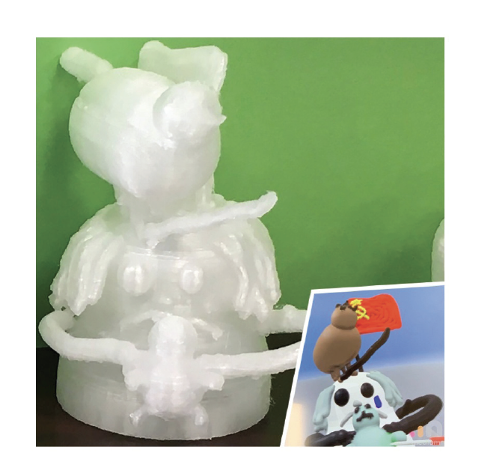
The student surveys collected at the end of the semester showed some interesting conclusions. Students commented that the experience of being completely immersed in an authentic environment helped them to focus on the task. The final project also increased excitement about the material and learning in general. Despite the initial sense of panic experienced by some, students reported that they loved the “freedom to create” and the “freedom to express themselves” in the target language. Artistic self-expression ultimately translated into the need to be creative using the target language, as using notes in VR was not an option. I could see how VR-infused instruction could offer an efficient alternative to the traditional types of assessment, liberating students from dependence on notes, flashcards, and glossaries while encouraging creativity in the target language.
The inability to use their notes was not a comfortable sensation for many students, although, in the end, several commented on the “freedom to think on your feet.” For me, using VR became the best solution to break students’ reliance on notes and encourage them to start creating with the target language. It was also evident that project-based assignments like the ones described should be integrated throughout the semester and that activities and assessments should be scaffolded for the best results.
New Activities
In the Fall 2021 iteration of the course, I developed a series of activities and project-based assignments utilizing Virtual Reality and immersive technology such as Oculus Quest and Google Cardboard. I introduced virtual reality field trips to 360-degree sites with art installations, sculptures, and outdoor museums. I designed assignments and project-based activities that utilize immersive technology to enhance communicative competence, help retain the material, and encourage vocabulary acquisition. For this course, students had to purchase a Google Cardboard or a Merge VR/AR headset. I also had a couple of them at my office for students to borrow.
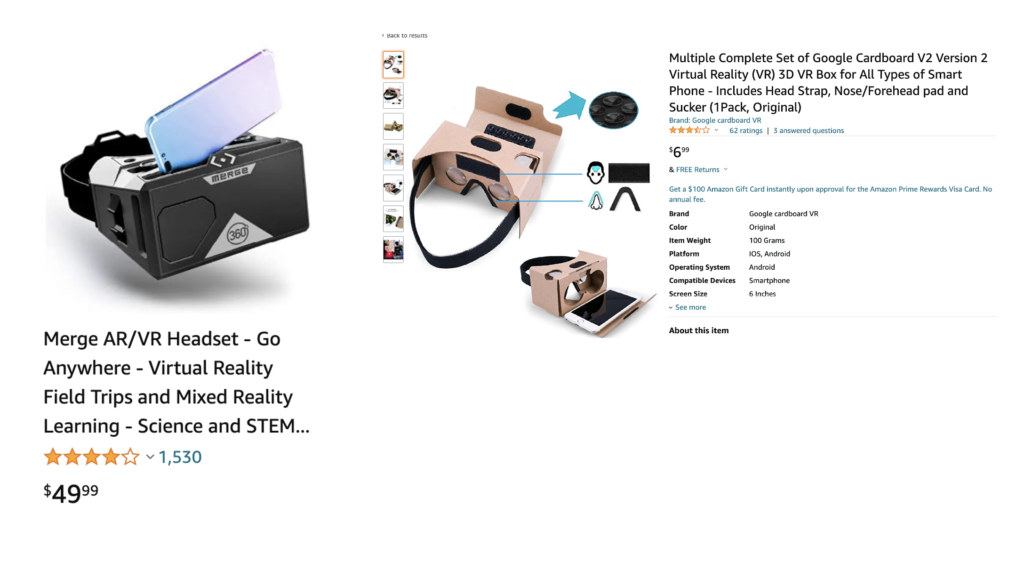
Due to COVID-19, obtaining and developing 360-degree footage of cultural sites was problematic, and I had to rely on images I could find on the web. My primary two sources were YouTube and the 360 Cities website. The latter site has many free features for educators and is a fantastic resource that contains many 360-degree images with annotations, maps, and featured videos from sites worldwide. I have to note my class did not focus entirely on Russian art. I used the textbook Russian Through Art: From Intermediate to Advanced Students by Anna Kudyma and Olga Kagan; I supplemented it with materials that provided a comparative perspective.
Activity one: VR journey narration
For this activity, students had to use their VR sets to watch The Starry Night Stereo VR experience. They had to narrate their experience while describing the paintings, atmosphere, and colors.
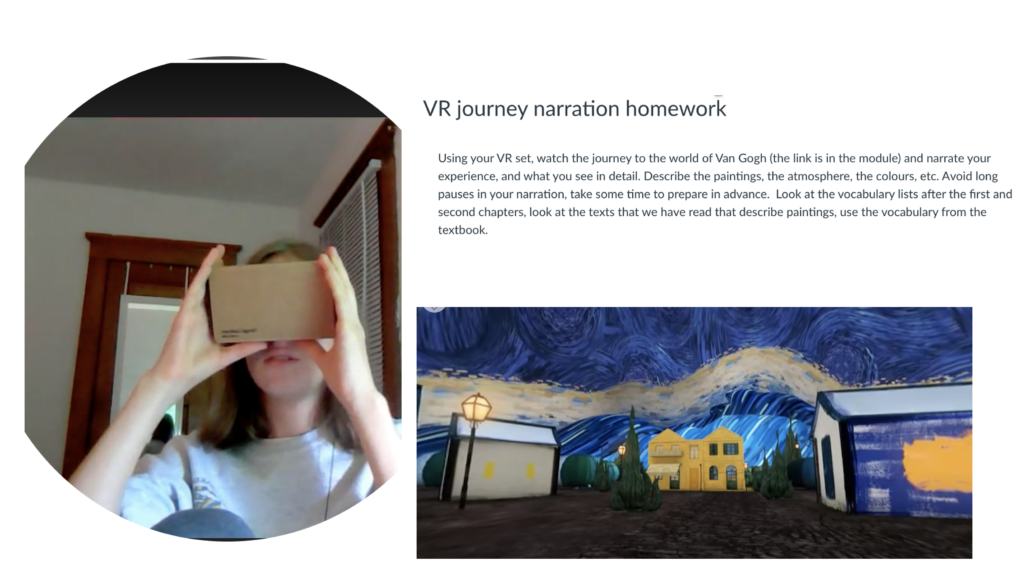
Activity two: Hermitage Museum visit (modified)
In the previous course iteration, I relied on VR equipment in the Language Lab, but supervising, guiding, and recording every student became very time-consuming. This time, I decided to rework my instructions to have students do all of the work during a single class session. Students did most of the preparation at home (the assignment tested prepared speech). When they came to class, they worked in pairs, recording each other with their phones.
 |
|---|
|
Final Project Part 1 instructions: This Friday’s class session is meant to prepare you for Part 1 of the Final Project that will happen on Monday in class. What is Part 1 of the Final Project? Please bring your VR set (merge or cardboard) to class on Monday. This is the room you will find yourself in. Open the link on your phone. Open VR view and put your phone in the VR set. Find yourself to be immersed in the environment. Pick four objects (could be a combination of paintings and sculptures) that you will focus on in more detail in your presentation. You have discussed the pieces in your group, if you need to read about them again, go to this page and find your pieces. You will see “i” icon near every piece of art. If you click on it, you will see the description of the art piece in Russian. It should help you in your preparation. So, when you are in VR set, no English should be used, only Russian. You are expected to tell a little bit about what you see in the gallery, and then focus on the pieces of your choice and talk about them in detail. Your presentation should be 4 minutes long. In the class on Monday, you will be split in pairs. Using phones, each person will film his/her partner completing the peaking task. What to expect:
When done, you will upload your video or provide the link to your google drive folder (make sure that you choose the settings “everyone with the link can view”) in the next assignment. |
Table 1 – Final project instructions.
Activity three: Art Installations
Art installations were one of the topics we discussed in class. I selected nine installations on the 360 cities website for this activity. Students had to see all of them in their VR headsets and select five to describe in Russian. I wanted students to pause the recording when switching between installations; for this reason, I used Flip, which has this functionality. Below are detailed instructions and some visuals from the selected installations.
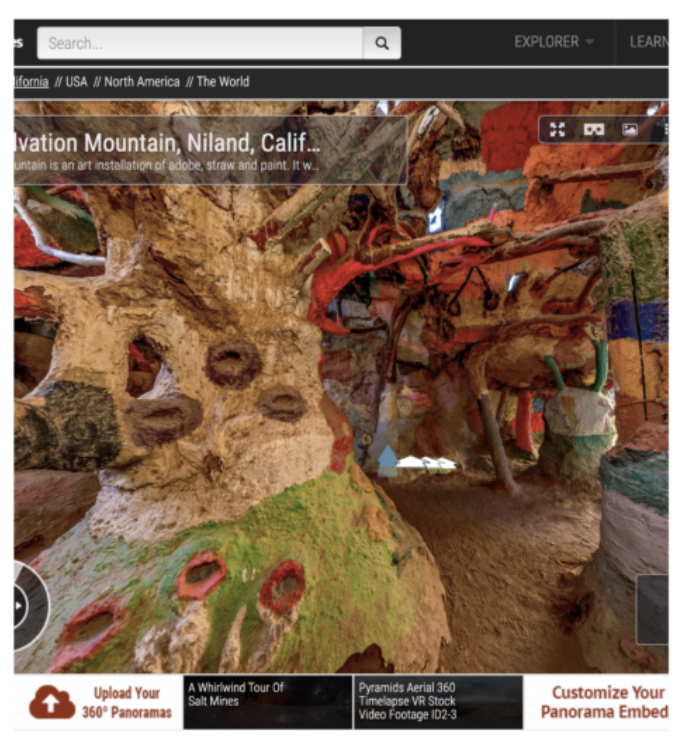 |
|---|
| Final project_part 2
We have discussed the art of installations in this unit, and the topic for the second part of the final project is installations. Take a look at all installations under the below links. Please use your google cardboards of VR headsets to be immersed in every installation. Choose 5 pieces that you want to describe briefly. Describe each piece in three to five sentences. Choose your favorite one. Describe your favorite piece in more detail. Look at the active vocabulary to talk about the art of installation. In your last description, you have to narrate what the artist wanted to achieve, what he or she wanted to elicit and what emotions he wanted to produce in the audience. Check the text about installation again and make sure to use vocabulary from there. The use of the Unit vocabulary will be taken into account when grading this assignment. Submission: This assignment is private, and no one except me will have access to your video. You have to video record yourself narrating in accordance with the above instructions. In between installations, pause the video so you do not record the whole time, only when you speak. Let me know if you have any questions. https://www.360cities.net/image/figurones-fluo-installation-urban-art https://www.360cities.net/image/tricolor-an-installation-art-at-french-embassy-tokyo https://www.360cities.net/image/agathe-de-bailliencourts-installation-art-tokyo https://www.360cities.net/image/westfjords-driftwood-installation https://www.360cities.net/image/takashi-nakajima-the-beautiful-the-ugly-tokyo https://www.360cities.net/image/salvation-mountain-niland-california-1 https://www.360cities.net/image/salvation-mountain-niland-california-2 https://www.360cities.net/image/slab-city-art-niland-california-1 |
Table 2 – Detailed project instructions and visuals from the selected installations.
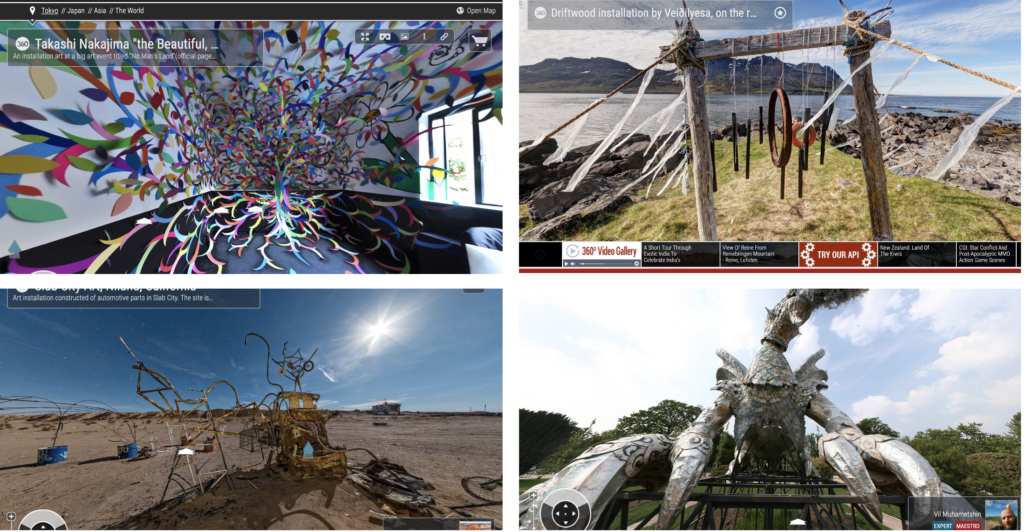
Activity four: Sculptures and a follow-up activity
I selected three sculptures made of different materials and located at various sites for students to watch in VR on the 360 cities website. Students used vocabulary to describe the sculptures and their locations in detail.
|
W14_project-based Monday For this class, get your VR headsets ready, as you will be experiencing some sculptures in an immersive way. Here are several sculptures I selected for you. Make sure to click the icon “watch in VR”:
|
|---|
Table 3 – Detailed project instructions.
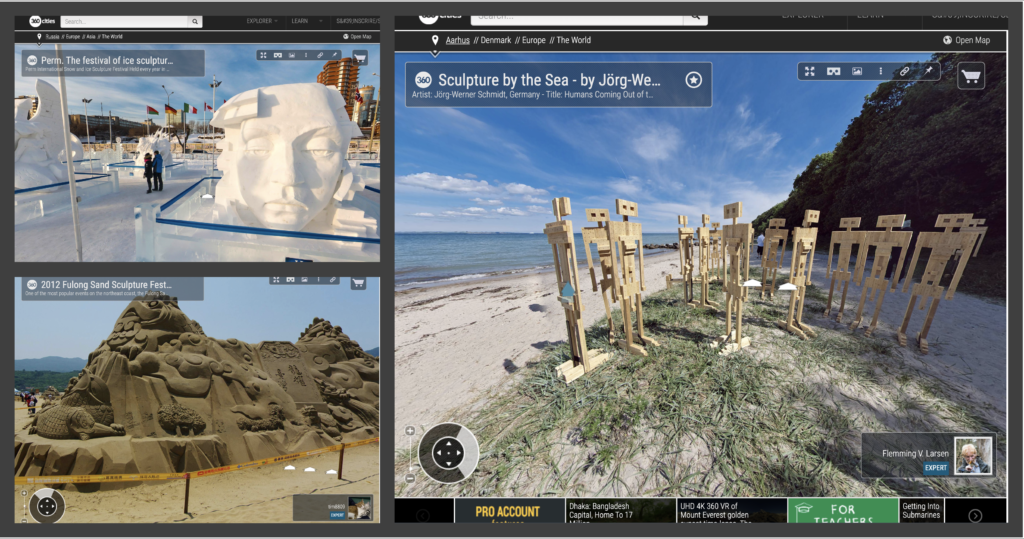
The follow-up activity asked students to explore the 360 Cities website and look for a sculpture they liked, describe it in writing in a discussion forum, and provide the link to the image. Students then read other students’ submissions and had to leave a couple of meaningful comments in Russian.
Additional Experiential Learning Opportunities
VR-centered activities in this class were only a part of the experiential learning opportunities I wanted to incorporate. Other activities included a visit to a 9/11 memorial quilt exhibition that included a discussion of art as a therapeutic medium for healing trauma. Students learned about such movements as Socialist Realism, Realism, Constructivism, Abstract Art, and Soviet Pop Art by creating pieces using paints and other materials and presenting them. Such assignments allowed students to engage with art in a meaningful and personal way, to reflect on class material, and to situate their work in a theoretical framework.
Student Feedback
The majority of students responded positively to the experience of using VR in the classroom. Students wrote the following in their course evaluations:
- Student 1: “This course successfully engages students in both language and culture, promotes individual creativity and critical thinking, and familiarizes us with new technology.”
- Student 2: “It was fun to be creative and try new art styles through different mediums like paint and VR while improving my Russian skills. It is my favorite class I have taken at UNL so far.”
- Student 3: “Learning about art in Russian was enjoyable for me, and I felt like a new step towards fluency.”
- Student 4: “This course was challenging but extremely rewarding. I will take a lot more away from the course because of the challenges it presented.”
- Student 5: “I felt really behind and bad at Russian when the course began, but I have felt my overall comprehension and speaking improve tremendously! I love this course and wish I was this challenged in every course every semester!”
- Student 6: “I loved this class! I felt as though I advanced a lot in my Russian skills through a variety of practice exercises, interesting learning material, and engagement in class.”
- Student 7: “I appreciate the many opportunities to speak, listen to and write in Russian.”
Benefits of VR in a Language Classroom
I have used technology extensively in my classes to enhance students’ engagement with class material. VR provides an incredible opportunity to build educational content that allows for an immersive, interactive, and engaging learning experience. While utilizing VR in my classroom, I have observed several benefits. Learning activities, virtual tours, and formative assessments designed for use with VR headsets facilitate student engagement and motivation; they resemble real-life interaction in an authentic environment; they provide experiential learning opportunities while exciting additional interest in class content; they encourage creativity and collaborative effort among students. Most importantly, students’ speaking proficiency has improved significantly over the course of the semester. VR helps break the habit of relying on notes, and in my experience, it has proven to be the most efficient way to help students start creating with the language in paragraph-long discourse.
My Afterthoughts
The transition between producing speaking responses consisting of a string of sentences at Intermediate Low/Mid to speaking in paragraph-length discourse at the Intermediate High/Advanced Low is challenging and stressful for students. Once students break the habit that keeps them dependent on their notes, they become more comfortable and confident creating in the target language. Confidence comes with practice, and habits take time to break. While teaching 300-level courses, I realized that language curricula at the beginner and intermediate levels need to be better aligned with learning outcomes, especially with regard to speaking skills. Incorporating VR-infused instruction early in the program could help students develop strong speaking skills, prepare students for transitions between the levels, and help them develop efficient learning habits.
References
Enkin, E., Tytarenko, O., & Kirschling, E. (2021). Integrating and Assessing the Use of a “Makerspace” in a Russian Cultural Studies Course: Utilizing Immersive Virtual Reality and 3D Printing for Project-Based Learning. CALICO Journal, 38(1), 103–127. https://doi.org/10.1558/cj.40926

